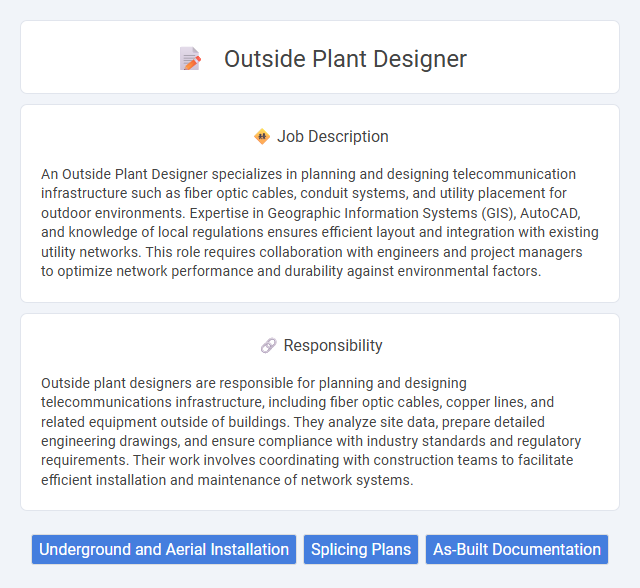
An Outside Plant Designer specializes in planning and designing telecommunication infrastructure such as fiber optic cables, conduit systems, and utility placement for outdoor environments. Expertise in Geographic Information Systems (GIS), AutoCAD, and knowledge of local regulations ensures efficient layout and integration with existing utility networks. This role requires collaboration with engineers and project managers to optimize network performance and durability against environmental factors.
Individuals who have strong spatial awareness and enjoy problem-solving in outdoor environments are likely well-suited for an Outside Plant Designer role. Those comfortable working in various weather conditions and managing detailed technical layouts for telecommunications infrastructure may find this job fulfilling. People who prefer flexible, site-based work rather than a traditional office setting could probably adapt and thrive in this position.
Qualification
An Outside Plant Designer must possess a strong background in civil or telecommunications engineering, accompanied by proficiency in CAD software and GIS mapping tools to create accurate infrastructure plans. Expertise in fiber optics, copper cabling, conduit systems, and industry standards such as NESC and OSHA regulations is essential for ensuring compliant and efficient network layouts. Effective communication skills and experience with project management are critical for coordinating with construction teams, vendors, and clients throughout the design and implementation phases.
Responsibility
Outside plant designers are responsible for planning and designing telecommunications infrastructure, including fiber optic cables, copper lines, and related equipment outside of buildings. They analyze site data, prepare detailed engineering drawings, and ensure compliance with industry standards and regulatory requirements. Their work involves coordinating with construction teams to facilitate efficient installation and maintenance of network systems.
Benefit
An outside plant designer likely enhances telecommunications infrastructure by planning and optimizing cable routes and network layouts. This role probably offers benefits such as competitive salaries, opportunities for career growth, and exposure to cutting-edge technology. Employees might also enjoy job stability due to the ongoing demand for reliable communication networks.
Challenge
The Outside Plant Designer role likely involves navigating complex infrastructure challenges related to telecommunications and utility networks. Managing physical constraints such as varied terrain, regulatory compliance, and integration with existing systems appears to demand strong problem-solving skills and adaptability. Overcoming these obstacles probably requires detailed planning and collaboration with multiple stakeholders to ensure efficient and reliable network deployment.
Career Advancement
Outside plant designers specializing in telecommunications infrastructure can advance their careers by gaining expertise in fiber optic technology, network planning, and CAD software. Progression often leads to roles such as senior engineer, project manager, or network architect, leveraging hands-on experience in designing and implementing complex outside plant systems. Certifications like BICSI Registered Communications Distribution Designer (RCDD) enhance credentials and open opportunities for leadership positions in telecom engineering firms.
Key Terms
Underground and Aerial Installation
Outside plant designers specialize in planning and designing infrastructure for telecommunications networks, focusing on underground and aerial installations. They create detailed layouts for placing cables, conduit systems, and utility poles, ensuring optimal routing and compliance with safety standards. Proficiency in GIS mapping, CAD software, and knowledge of local regulations is essential for coordinating efficient deployment of fiber optic and copper cables in diverse environments.
Splicing Plans
An Outside Plant Designer specializing in Splicing Plans develops detailed maps and documentation for fiber optic cable splicing locations, ensuring accurate connectivity and minimal signal loss. They coordinate with field technicians to optimize splice points based on network layout, cable types, and environmental factors, enhancing overall network reliability. Proficiency in CAD software and knowledge of fiber optic standards like ITU-T and ANSI are essential for creating precise, compliant splicing schematics.
As-Built Documentation
Outside plant designers specialize in creating detailed As-Built documentation that accurately reflects installed telecommunications infrastructure, including fiber optic cables, conduit, and utility poles. Precise As-Built drawings ensure compliance with engineering standards and facilitate future maintenance or upgrades by providing exact locations, specifications, and materials used in the outside plant environment. Expertise in geographic information systems (GIS) and CAD software is essential for producing reliable and up-to-date documentation critical to project success and regulatory adherence.
 kuljobs.com
kuljobs.com